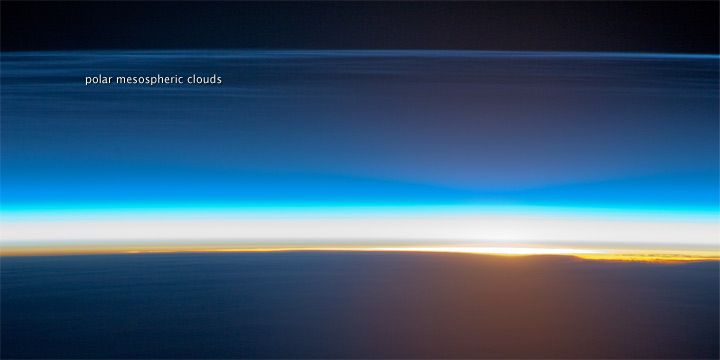Stratosphere
Above the tropopause lies the stratosphere. Note in Figure 3.8 that the temperature of the air does not change with an increase in elevation. If a layer of air exhibits no change in temperature with an increase in elevation we typically refer to it as an isothermal layer i.e. layer of equal temperature. Through most of the stratosphere the air temperature increases with an increase in elevation creating a temperature inversion. The inverted lapse rate of temperature is due to the presence of stratospheric ozone which is a good absorber of ultra-violet radiation emitted by the Sun. As energy penetrates downward, less and less is available for lower layers and hence the temperature decreases toward the bottom of the stratosphere. The downward reduction of heat transfer due to solar energy absorption from above is offset by the heat given off by the Earth creating the isothermal layer at the bottom of the stratosphere. At the top of the stratosphere lies the stratopause. Like the tropopause, the stratopause is an isothermal layer that separates the stratosphere from the mesosphere.
Mesosphere and beyond
It is the properties of the previously discussed layers that affects most of what we study in physical geography. Processes acting in layers above the stratopause have relatively little impact on our elemental study of Earth near-surface processes. In the mesosphere air temperatures begin to decrease with increasing altitude. 99.9 percent of the gases that comprise the atmosphere lie below this level. The air of the mesosphere is thus extremely thin and air pressure very small. With very few molecules like ozone capable of absorbing solar radiation, especially near the top of the layer, the air temperature decreases with height. The mesopause separates the mesosphere from the thermosphere above.
Figure 3.8 shows air temperature increasing with increasing altitude in the thermosphere. Here, energetic oxygen molecules absorb incoming solar radiation raising the layer's temperature. Because solar activity determines the temperature of the layer, temperature at the top of the layer is warmer than that near the bottom of the thermosphere. Even though the temperatures are quite high in the thermosphere, the heat content of the layer is very low due the low density of air at this level.

Figure 3.9 Polar Mesospheric clouds. Courtesy NASA EOS (Source) Polar mesospheric clouds are also known as noctilucent or "night-shining" clouds as they are usually seen at twilight. These clouds form at high latitudes and high altitudes (76 - 85 kilometers) near the boundary of the mesosphere and thermosphere.
Functional layers
Two layers, the ionosphere and ozonosphere are identified when using function as the criterion for subdivision. The ionosphere is not really a layer of the atmosphere, but an electrified field of ions and free electrons. The ionosphere absorbs cosmic rays, gamma rays, X-rays, and shorter wavelengths of ultraviolet radiation. The spectacular display of auroral lights is generally found in this region.
Figure 3.10 Functional Layers (Not available yet)
The ozonosphere, also called the "ozone layer", is the concentrated layer of ozone found in the stratosphere. Ozone (O3) absorbs ultraviolet light between 0.1 - 0.3µm. The ozone layer absorbs 97 - 99% of the Sun's ultraviolet light that can be harmful to life on earth. Though relatively constant through millions of years, seasonal fluctuations of ozone especially over the Arctic and Antarctic are common. The ozone layer is thinner at the equator and thicker at the poles. Ozone concentrations are highest in the spring and generally lowest during the autumn.
Video: Reveal Earth's Atmosphere
Courtesy National Geographic
Assess your basic understanding of the preceding material by Looking Back at Atmospheric Structure or skip and continue reading.
